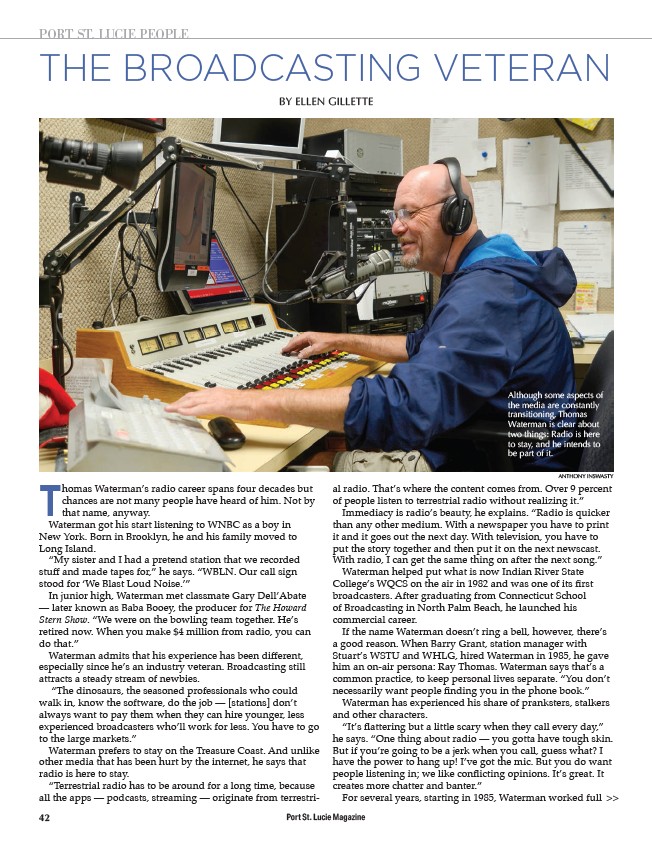
PORT ST. LUCIE PEOPLE
THE BROADCASTING VETERAN
al radio. That’s where the content comes from. Over 9 percent
of people listen to terrestrial radio without realizing it.”
Immediacy is radio’s beauty, he explains. “Radio is quicker
than any other medium. With a newspaper you have to print
it and it goes out the next day. With television, you have to
put the story together and then put it on the next newscast.
With radio, I can get the same thing on after the next song.”
Waterman helped put what is now Indian River State
College’s WQCS on the air in 1982 and was one of its first
broadcasters. After graduating from Connecticut School
of Broadcasting in North Palm Beach, he launched his
commercial career.
If the name Waterman doesn’t ring a bell, however, there’s
a good reason. When Barry Grant, station manager with
Stuart’s WSTU and WHLG, hired Waterman in 1985, he gave
him an on-air persona: Ray Thomas. Waterman says that’s a
common practice, to keep personal lives separate. “You don’t
necessarily want people finding you in the phone book.”
Waterman has experienced his share of pranksters, stalkers
and other characters.
“It’s flattering but a little scary when they call every day,”
he says. “One thing about radio — you gotta have tough skin.
But if you’re going to be a jerk when you call, guess what? I
have the power to hang up! I’ve got the mic. But you do want
people listening in; we like conflicting opinions. It’s great. It
creates more chatter and banter.”
For several years, starting in 1985, Waterman worked full
Thomas Waterman’s radio career spans four decades but
chances are not many people have heard of him. Not by
that name, anyway.
Waterman got his start listening to WNBC as a boy in
New York. Born in Brooklyn, he and his family moved to
Long Island.
“My sister and I had a pretend station that we recorded
stuff and made tapes for,” he says. “WBLN. Our call sign
stood for ‘We Blast Loud Noise.’”
In junior high, Waterman met classmate Gary Dell’Abate
— later known as Baba Booey, the producer for The Howard
Stern Show. “We were on the bowling team together. He’s
retired now. When you make $4 million from radio, you can
do that.”
Waterman admits that his experience has been different,
especially since he’s an industry veteran. Broadcasting still
attracts a steady stream of newbies.
“The dinosaurs, the seasoned professionals who could
walk in, know the software, do the job — stations don’t
always want to pay them when they can hire younger, less
experienced broadcasters who’ll work for less. You have to go
to the large markets.”
Waterman prefers to stay on the Treasure Coast. And unlike
other media that has been hurt by the internet, he says that
radio is here to stay.
“Terrestrial radio has to be around for a long time, because
all the apps — podcasts, streaming — originate from terrestri-
42 Port St. Lucie Magazine
ANTHONY INSWASTY
BY ELLEN GILLETTE
>>
Although some aspects of
the media are constantly
transitioning, Thomas
Waterman is clear about
two things: Radio is here
to stay, and he intends to
be part of it.